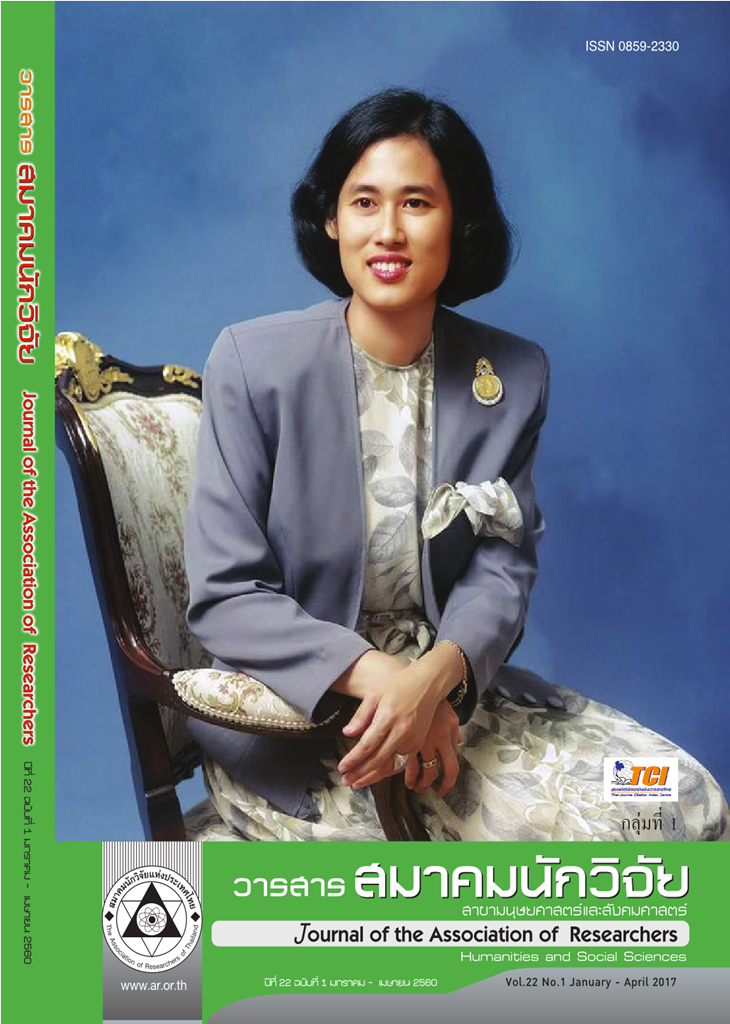Cultural Inheritance “Saomai” Dance and Guidelines for Development to be as a Social Marketing Product
Main Article Content
Abstract
The objectives of this study were to study the existence of the cultural community, to seek and restore the guidelines of cultural inheritance with regard to “Saomai” Dance for three generations and to find out the guidelines of “Saomai” Dance development, which is to be used as a social marketing product in Siriwiangchai Sub-district Municipality, Wiang Chai District Chiangrai Province. The study was a Participatory Action Research (PAR) focusing on two groups of people: community leaders and residents, including three generations of the above, children, youth and adults. Data collection was done by interview, focus group and training in “Saomai” Dance. Data analysis was done by classifying information obtained and summarizing it into a descriptive essay. Results showed that the community of Siriwiangchai Sub-district Municipality, Wiang Chai District Chiangrai Province still expresses a wide variety of local cultures and most activities were related both to traditions and Buddhist activities. As to the search for and restoration of guidelines of cultural inheritance of “Saomai” Dance for three generations, it appeared that the models and skills development as well as teaching and training were means to convey cultural wisdom into practical results. Regarding the development of “Saomai” Dance as a social marketing product, the community should be able establish a group of dancers, develop a group management system with dance performance as a social marketing product to express cultural dance in order to maintain its existence in the community.
Article Details
บทความที่ปรากฏในวารสารนี้ เป็นความรับผิดชอบของผู้เขียน ซึ่งสมาคมนักวิจัยไม่จำเป็นต้องเห็นด้วยเสมอไป การนำเสนอผลงานวิจัยและบทความในวารสารนี้ไปเผยแพร่สามารถกระทำได้ โดยระบุแหล่งอ้างอิงจาก "วารสารสมาคมนักวิจัย"
References
ณัฐฐ์วัฒน์ สุทธิโยธิน. (2556). การสืบทอดทางวัฒนธรรม (cultural inheritance) ที่ประสบความสำเร็จ. สืบค้นเมื่อ 20 ธันวาคม 2556, จาก http://nattawats.blogspot.com/2013/04/cultural-inheritance.html
นงเยาว์ อำรุงพงษ์วัฒนา. (2541). ศิลปะการฟ้อนผู้ไทย จังหวัดนครพนม. สืบค้นเมื่อ 15 มกราคม, 2558 จาก ฐานข้อมูล การวิจัยการศึกษา ศาสนา และวัฒนธรรม: http://www.thaiedresearch.org/thaied/
บัวเรียว รัตนมณีภรณ์. (2558, มีนาคม 4). แม่ครูนาฏศิลป์, สัมภาษณ์.
ประภัสสร โพธิ์ศรีทอง. (2558). โลกาภิวัตน์กับการจัดการวัฒนธรรม. สืบค้นเมื่อ 5 สิงหาคม 2558, จาก http://www.oknation.net/blog/thaitourismsociety/2013/10/04/entry-1
พันทิพา มาลา และ ลำยอง ปลั่งกลาง. (2553). แนวทางการฟื้นฟูวัฒนธรรมชุมชนเพื่อส่งเสริมการท่องเที่ยว : กรณีศึกษาชุมชนอeเภอบ้านแพรก จังหวัดพระนครศรีอยุธยา. พระนครศรีอยุธยา : สถาบันอยุธยาศึกษา มหาวิทยาลัยราชภัฏพระนครศรีอยุธยา.
มรดกภูมิปัญญาทางวัฒนธรรม. (2558). การฟ้อนสาวไหม. สืบค้นเมื่อ 15 มกราคม 2558, จาก http://ich.culture.go.th/index.php/th/ich/performing-arts/236-performance/310-----m-s
วิรัตน์ คำศรีจันทร์. (2554). พลังความรู้การวิจัยแบบ PAR. กรุงเทพฯ : พี. เอ. ลีฟวิ่ง.
สมชัย ใจดี และ ยรรยง ศรีวิริยาภรณ์. (2545). ประเพณีและวัฒนธรรมไทย. กรุงเทพฯ : ไทยวัฒนาพานิช.
สำนักงานวัฒนธรรมจังหวัดลำปาง. (2551). โครงการวิจัยแบบมีส่วนร่วมของเครือข่ายวัฒนธรรมและชุมชนในการบริหารจัดการวัฒนธรรม กรณีศึกษากลุ่มก๋องปู่จาบ้านวังหม้อ ต.ต้นธงชัย อ.เมืองจังหวัดลำปาง. ลำปาง: สำนักงานฯ.
สำนักงานคณะกรรมการวัฒนธรรมแห่งชาติ. (2551ก). คู่มือเครือข่ายศูนย์วัฒนธรรมในสถานศึกษา. กรุงเทพฯ : องค์การสงเคราะห์ทหารผ่านศึก.
______ (2551ข). สาระสำคัญงานวิจัยวัฒนธรรมเล่ม 1 ประจำปี 2524-2548. กรุงเทพฯ : สำนักงานฯ.
อมรา พงศาพิชญ์. (2547). สังคมและวัฒนธรรม : เอกสารประกอบการศึกษาวิชา 313-183. กรุงเทพฯ : ด่านสุทธา.
เอื้องฟ้า ถาวรรักษ์. (2555). การอนุรักษ์ สืบทอดศิลปะการแสดงพื้นบ้านชาวกะเหรี่ยง “รำตง” อำเภอศรีสวัสดิ์ จังหวัดกาญจนบุรี. กาญจนบุรี : สำนักงานวัฒนธรรมจังหวัดกาญจนบุรี.
References
Armstrong, G. and Kotler, P. (2015). Marketing An Introduction. (12th ed.). n.p.: Prentice Hall.
Amrungpongwattana, Nongyao. (1998). Phuthai Dance in Nakhon Phanom Province. Retrieved January 15, 2015 from http://www.thaiedresearch.org/thaied/ (in Thai).
Intangible culrutal heritage. (2015). Saomai dance. Retrieved January 15, 2015 from http://ich.culture.go.th/index.php/th/ich/performing-arts/236-performance/310-----m-s (in Thai).
Jaidee, Somchai and Sriviriyaporn, Yanyong. (2002). Thai Custom and Culture. Bangkok: Thai Watana Panich. (in Thai).
Kotler, P. (2000). Marketing Management. (10th ed.). Upper Saddle River, New Jersey: Prentice-Hall.
Kamsrichan, Wirat. (2011). Participatory Action Research. Bangkok: P. A. Living. (in Thai).
Lampang Provincial Culture Office. (2008). The research study of participation to cultural network and community for cultural management : A case study of Ban Wang Mor village, Lampang province. Lampang: Lampang Provincial Culture Office. (in Thai).
Mala, Phunthipa and Plangklang, Lumyong. (2010). Rehabilitation guidelines for community culture to promote tourism: case study Ban Phraek community, Ayutthaya. Ayutthaya : Ayutthaya Studies Institute, Phranakhon Si Ayutthaya Rajabhat University. (in Thai).
Musika, Khumla. (2013). Cultural heritage management of a community, A case study: Glong Toom Dancing and Drumming from Ubon Ratchathani province. Area Base Development Research Journal, 5(6), pp. 21-35. (in Thai).
Office of The Nation Culture Commission. (2008a). A Guidebook for cultural network on education.Bangkok: The War Veterans Organization of Thailand. (in Thai).
______ (2008b). The Major of cultural research Volume 1 Annual 1981-2005. Bangkok: Office of The Nation Culture Commission. (in Thai).
Posrithong, Prapassorn. (2015). Globalization and cultural management. Retrieved August 5, 2015 from http://www.oknation.net/blog/ thaitourismsociety/2013/10/04/entry-1 (in Thai).
Pongsapich, Amara. (2004). Social and culture: Handout of Course 313-183. Bangkok: Darnsutha.(in Thai).
Rattanamaneeporn, Buariao. (2015, March 4). Lanna Dance Artist. Interview.Sutthiyothin, Nattawat. (2013). Successful cultural inheritance. Retrieved December 20, 2014 from http://nattawats.blogspot.com/2013/04/cultural-inheritance.html (in Thai).
Thavornlak, Aeungfah. (2012). Preservation of folk art performance Karen "Ram Tong", Si Sawat district,Kanchanaburi Province. Kanchanaburi : Kanchanaburi Provincial Culture Office. (in Thai).


